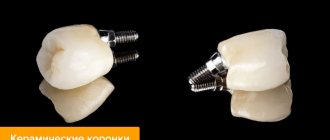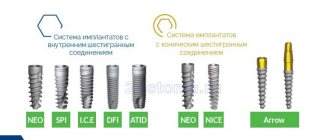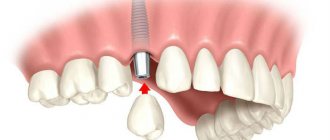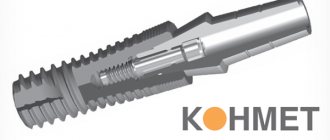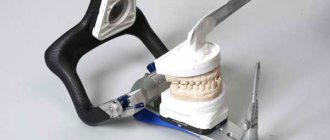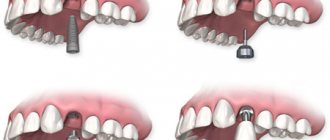Article navigation question to a specialist
Orthodontic mini-implants (or mini-implants) have nothing to do with dental implantation and restoration. They have the prefix “orthodontic”, so they are used specifically for correcting the bite and moving teeth in a row.
Mini-implants are small titanium screws that are used to create additional support when installing braces.
Correction of bite with internal braces Win - 180,000 rubles.
All inclusive!
Preparation and treatment of the oral cavity, consultation with an orthodontic specialist, installation and adjustment of orthodontic structures. The price is for one jaw. Free consultation with an orthodontist +7 (495) 789-39-31 or write to us
What are mini implants in dentistry?
These are smaller models of classic dental implants. Available in diameters of 1.8-2.4 mm and lengths of 6-10 mm. Mini dental implants are used in special clinical cases, mainly as temporary supports for removable dentures.
Application area:
- Removable prosthetics in conditions of jaw bone atrophy - for the installation of mini-rods, the height and density of bone tissue does not matter. They are fixed in the gums in a minimally invasive way without involving bone structures, creating additional support for the artificial dentition. After implantation, a prosthesis made of lightweight materials is immediately installed. However, the design has serious limitations in terms of chewing load.
- Temporary prosthetics while classic implants take root are important when restoring all teeth. The patient can eat normally and not feel aesthetic discomfort thanks to a removable denture installed on mini implants.
- In orthodontics - to create a fixed support for braces, to accelerate the movement of teeth in case of complex bite defects. Also as supporting elements when splinting mobile teeth.
Types of mini-implants
Due to the fact that this system is relatively new, not every structural manufacturing company offers its products. Today there are several models available:
- MDI are products from America, which are fixed to the lower jaw. The peculiarity is a special thread that can take root even in loose bone. The fastening rings of removable dentures promote strong fixation when adjacent rods are deflected. The structures can be subjected to normal loading 2-3 hours after surgery.
- Nobel - manufactured by Biocare. With their help, it is possible to restore a number of teeth even in the case of complete tissue atrophy. The products are taking root quite well. The only drawback is the short service life; the manufacturer provides only a ten-year warranty.
- Xive is a product from Germany. A special feature is its resistance to full chewing loads. The products do not cause rejection; such mini-implants are installed on the upper jaw, but sometimes also on the lower jaw.
- Zimmer are American made products. The company uses not only titanium alloys, but also tantalum to make the rod. This contributes to a stronger and more reliable fixation in the tissues. Thanks to this, the base is reliably stabilized and the risk of breakage is minimized. This is the best option for people diagnosed with bruxism.
- Vector TAS. In addition to the standard design, these implants have additional elements - stoppers, as well as rings that do not have threads. These details protect the gums from various injuries, and also minimize the risk of hypertrophy during use. In addition, the system uses colored satin, as well as wire, which is necessary for additional fixation of structures.
Vector Tas
The main purpose of mini-implants is to support a removable denture with partial and complete edentia
We do not use such models for prosthetics with single crowns and bridges. This is due to instability to loads. Mini-implants are not capable of creating reliable support for a full-fledged prosthesis made of ceramics, metal-ceramics or zirconium. Under pressure they can fall into the bone tissue or cause the orthopedic structure to dislodge.
Levin Dmitry Valerievich
Chief physician, Ph.D.
General overview
From a technical point of view, a mini-implant is a structure implanted into tissue using a transgingival technique, replacing the lost root part of a tooth, and allowing the load of the prosthesis in the early stages of integration. Visually, the system is similar to a screw on which a titanium abutment is located, which serves as the basis for an artificial crown.
Kinds
- One-piece - monolithic design. It combines the lower intraosseous part (an artificial analogue of a tooth root) and the upper part (abutment), which, after implantation, remains above the surface of the gum and is connected to the prosthesis.
- Two-piece - include two separate elements: a titanium rod and an abutment, which is fixed before the prosthetic stage.
Single-component implants are inferior in characteristics to two-component ones, since they are non-separable. If the abutment wears out, the entire structure will have to be removed.
Indications
In our Center, mini implants are used to fix removable dentures in the following cases:
- the need to restore teeth with partial and complete edentia;
- impossibility of using classical implants (for pathologies of the dentofacial apparatus);
- atrophy of the jaw bone, if the patient refuses the procedure for increasing the missing volume;
- instability or discomfort when wearing a removable denture;
- lack of finances for full implantation;
- elderly patient.
In the vast majority of clinical situations, prosthetics on mini-implants is a temporary solution (during bone grafting, classical implantation). It is used to relieve the patient of aesthetic and functional discomfort during prolonged treatment. During the period of engraftment of classic titanium roots, mini-rods are fixed to support a temporary prosthesis and removed before permanent prosthetics.
Possibility of use
Mini implants are used by orthodontists in the following clinical situations:
- in preparation for prosthetics: to prevent displacement of existing teeth if replacement of missing teeth cannot be done immediately;
- to correct the bite (in combination with braces): they correct the position of the teeth, fix them in the desired position and speed up the treatment process;
- for reliable fastening of removable orthodontic appliances (due to their excellent stabilization in the jaw) immediately after the operation of implanting pins.
Contraindications
- Blood diseases;
- diabetes;
- disturbances in the functioning of the immune, cardiovascular, and nervous systems;
- tuberculosis;
- mental disorders;
- allergic reaction to anesthesia;
- malignant neoplasms;
- periodontal, bone or connective tissue diseases;
- smoking, drug addiction, alcoholism and poor oral hygiene are temporary restrictions.
The listed restrictions are similar for any type of surgical intervention.
Make an appointment with an implantologist
Installation steps
Preparatory
Includes sanitation of the oral cavity, study of the condition of the jaw bone. To identify possible contraindications to surgery, patients undergo tests. Then the future operation is planned, a treatment plan is drawn up, models and the location of the rods are selected.
Implantation
It is performed under local anesthesia in a minimally invasive manner. Punctures are made in the gums, then holes with a diameter of 1.1 mm and a length of 4-5 mm are formed using cutters, into which mini implants are screwed.
Prosthetics
Impressions are taken and sent to the dental technician. The finished artificial teeth are attached to titanium supports. It is possible to install the patient's previously used prosthesis (if it was used for up to 3 years). In the dental laboratory it is repositioned and equipped with special fasteners.
Options for fixing removable dentures
- On spherical abutments there is a classic method of fastening due to the silicone matrices with which the abutments are equipped. After connecting to the prosthesis, they ensure the immobility of the structure.
- Locator system - involves the use of equatorial abutments (they differ from spherical ones in shape). This type of fixation is wear-resistant and allows you to adjust the level of load on the implants. If you remove the silicone matrix, the pressure will only go to the soft tissue of the gums, while the titanium rods will not be loaded. This technique is relevant when it is not possible to achieve primary stability.
Price
Prosthetics with mini implants are relatively inexpensive. Installation of such rods is less technologically advanced. There is no need to first build up the jawbone during atrophy, which allows you to save on treatment.
However, it is worth considering that smaller models are not suitable for single installation (except for orthodontic treatment), so the final price is determined taking into account the number of rods installed.
In any case, the final cost of treatment is one and a half to two times less than using classic implants .
Advantages and disadvantages
Many patients have never heard of mini-implants; most often, dentists offer them standard orthopedic systems. But miniature titanium roots are no worse; they also have a number of advantages:
- They can be installed in limited spaces; in some cases, the patient does not require osteoplasty. This is one of the most important advantages of mini-systems, for which many implantologists value them so much.
- They do not injure soft tissues and are quickly screwed into the jaw bone without incisions or residual seams on the gums.
- Fast postoperative period. Due to their small size and lack of risk of injury, the process of osseointegration takes place in a short time.
- Affordable price.
- There are a minimal number of contraindications; this type of implantation is suitable even for older people.
- If you follow the operating rules, take care of the systems and choose the right type of prosthesis, the service life of these structures will increase several times.
To understand all the nuances of installing mini-implants, you should consider not only their advantages, but also their disadvantages. Every orthopedic system has them, and this design is no exception. Much has been said about the advantage of the small size of the titanium root, but this feature can also be a disadvantage. The fact is that due to the miniature nature of the products, they cannot fully replace real teeth. Also, they should not be overloaded, this is fraught with serious consequences. Therefore, they are not used in conjunction with bridges and crowns. If you have a need for implantation, then you should first consult with a qualified specialist who can choose the right model and type of implant for you.
Life time
With proper care, the structure will last a maximum of 8 years . This type of prosthetics is a temporary solution. Therefore, we recommend that patients receive a permanent fixed prosthesis after 2-3 years, supported by classic titanium roots with a lifelong service life.
Advantages
- Low cost of implants;
- easy installation;
- low morbidity;
- accelerated rehabilitation;
- fast terms of prosthetics;
- reliable fixation of a removable denture;
- smaller dimensions of the plastic base.
Flaws
- Impossibility of replacing one tooth or installing a fixed prosthesis;
- short-term results;
- full restoration of the functions and aesthetics of the dentition is not ensured;
- spherical abutments are poorly resistant to loads, wear out, and require replacement after 2-3 years.
Patient reviews
Irina, 36 years old
I gave birth, and my teeth began to decay catastrophically. As a result, the orthodontist offered me mini implantation. Standard implants would have cost me a lot more. Within an hour, I “grew” gorgeous, strong teeth.
Nikolay, 52 years old
My entire lower row of teeth gradually collapsed. The removable jaw left a terrible impression; it kept falling out. After installing microimplants, I simply began to live fully. The implants took root completely and nothing hurt. I wish I had installed them sooner.
Katerina Stepanovna, 66 years old
I’m not young anymore, and I don’t have many teeth. The doctor suggested mini-implantation to me because my jaws are weak and full-fledged implantation is contraindicated for me. I had 5 artificial teeth installed, everything went well, they all settled in perfectly.
Evgenia Vasilievna, 50 years old
The lack of teeth almost drove me to suicide. I couldn't use the artificial jaw because it was wobbly and my speech was slurred. I was generally afraid to chew, as the pain was terrible. The appearance of microprostheses in my life changed everything. This is a way out for people like me.
Based on many positive reviews from patients, we can judge mini-implants as a very successful invention of orthodontists that can help quickly restore lost teeth. And the affordable price of mini-designs allows even people with little income to fill their mouths with teeth.
Sources used:
- Lee, S. L. (2007). Applications of orthodontic mini implants. Hanover Park, IL: Quintessence Publishing Co, Inc.
- Chen, Y.; Kyung, H. M.; Zhao, W. T.; Yu, W. J. (2009). "Critical factors for the success of orthodontic mini-implants: A systematic review." American Journal of Orthodontics and Dentofacial Orthopedics.
- Ibragimov T. I., Bychkov A. I., Aleshin N. A., Tibilov V. F. Use of a new type of superstructure with a microshock absorber on dental implants in prosthetic treatment of patients with complete absence of teeth
Care
Despite the increased reliability of fastening the prosthesis in the oral cavity compared to a traditional removable one, it is equipped with an artificial gum and requires removal for hygiene procedures.
Basic care recommendations:
- To clean artificial teeth, purchase a toothbrush with soft bristles, toothpaste without abrasive particles, and an irrigator;
- visit the clinic once every 3-4 months to check the tightness of the fit of the orthopedic structure to the mucosa and monitor the degree of atrophy of the jaw bone;
- Eliminate solid foods from your diet.
